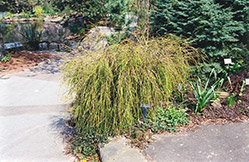It's all about ...
plants

Threadleaf Arborvitae
Thuja plicata 'Filiformis'
Height: 6 feet
Spread: 5 feet
Sunlight:
![]()
![]()
Hardiness Zone: 6b
Other Names: Giant Arborvitae, Western Red Cedar
Description:
Now here's a plant you won't find in every garden; ray-like sprays of fine-textured threaded foliage held in arching splays define this naturally dwarf garden gem; a real collector shrub that will set your garden apart from the neighbors, yet easy to grow
Ornamental Features
Threadleaf Arborvitae is a dwarf conifer which is primarily valued in the landscape or garden for its cascading habit of growth. It has attractive green evergreen foliage. The threadlike sprays of foliage are highly ornamental and remain green throughout the winter. The shaggy antique red bark adds an interesting dimension to the landscape.
Landscape Attributes
Threadleaf Arborvitae is an open multi-stemmed evergreen shrub with a shapely form and gracefully arching branches. It lends an extremely fine and delicate texture to the landscape composition which can make it a great accent feature on this basis alone.
This is a relatively low maintenance shrub. When pruning is necessary, it is recommended to only trim back the new growth of the current season, other than to remove any dieback. It has no significant negative characteristics.
Threadleaf Arborvitae is recommended for the following landscape applications;
- Accent
- Hedges/Screening
- General Garden Use
Planting & Growing
Threadleaf Arborvitae will grow to be about 6 feet tall at maturity, with a spread of 5 feet. It has a low canopy, and is suitable for planting under power lines. It grows at a slow rate, and under ideal conditions can be expected to live for 40 years or more.
This shrub does best in full sun to partial shade. It prefers to grow in average to moist conditions, and shouldn't be allowed to dry out. It is not particular as to soil type or pH. It is somewhat tolerant of urban pollution, and will benefit from being planted in a relatively sheltered location. Consider applying a thick mulch around the root zone in winter to protect it in exposed locations or colder microclimates. This is a selection of a native North American species.
This plant is not reliably hardy in our region, and certain restrictions may apply; contact the store for more information.
